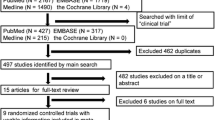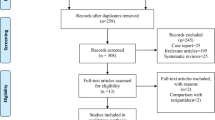Abstract
Background
Crohn’s disease impacts the bone health of patients and results in a high prevalence of low bone mineral density (BMD) disease such as osteoporosis and osteopenia. Bisphosphonates can reduce bone loss by inhibiting bone resorption.
Aim
To assess the effectiveness and safety of bisphosphonates for osteoporosis or osteopenia in Crohn’s disease.
Methods
A literature search included PubMed, EMBASE, the Science Citation Index, and the Cochrane Library was conducted to identify studies up to March, 2012. Randomized controlled trials (RCTs) comparing bisphosphonates with placebo or no intervention for osteoporosis or osteopenia in adult patients with Crohn’s disease were analyzed.
Results
Five RCTs involving 423 participants were included. All patients received daily calcium and vitamin D supplementation. Overall, bisphosphonates improved hip BMD at 12 months (n = 193, MD = 0.99, 95 % CI: 0.14–1.84) compared with placebos or no intervention. No significant differences of spine BMD at both 12 months (n = 193, MD = 1.78, 95 % CI: −0.99 to 4.55) and 24 months (n = 231, MD = 0.70 %, 95 % CI: −0.48 to 1.88), hip BMD at 24 months (n = 231, MD = 0.25 %, 95 % CI: −0.65 to 1.15), new vertebral fractures (n = 117, RD = −0.01, 95 % CI: −0.08 to 0.05) or adverse events (n = 422, RR = 1.03, 95 % CI: 0.71–1.49) between bisphosphonates groups and control groups were noted. Subgroup analyses of participants treated with corticosteroid in the preceding year found no difference between two groups.
Conclusions
There was no evidence to support the use of bisphosphonates for osteoporosis or osteopenia in Crohn’s disease. More randomized controlled clinical trials assessing the effects of bisphosphonates are needed.






Similar content being viewed by others
References
Bousvaros A, Antonioli DA, Colletti RB, et al. Differentiating ulcerative colitis from Crohn disease in children and young adults: report of a working group of the North American Society for Pediatric Gastroenterology, Hepatology, and Nutrition and the Crohn’s and Colitis Foundation of America. J Pediatr Gastroenterol Nutr. 2007;44:653–674.
Khor B, Gardet A, Xavier RJ. Genetics and pathogenesis of inflammatory bowel disease. Nature. 2011;474:307–317.
Schulte C, Dignass AU, Mann K, Goebell H. Reduced bone mineral density and unbalanced bone metabolism in patients with inflammatory bowel disease. Inflamm Bowel Dis. 1998;4:268–275.
Pollak RD, Karmeli F, Eliakim R, Ackerman Z, Tabb K, Rachmilewitz D. Femoral neck osteopenia in patients with inflammatory bowel disease. Am J Gastroenterol. 1998;93:1483–1490.
Von Tirpitz C, Pischulti G, Klaus J, et al. Pathological bone density in chronic inflammatory bowel diseases–prevalence and risk factors. Z Gastroenterol. 1999;37:5–12.
Bjarnason I, Macpherson A, Mackintosh C, Buxton-Thomas M, Forgacs I, Moniz C. Reduced bone density in patients with inflammatory bowel disease. Gut. 1997;40:228–233.
Klaus J, Armbrecht G, Steinkamp M, et al. High prevalence of osteoporotic vertebral fractures in patients with Crohn’s disease. Gut. 2002;51:654–658.
Hill RJ, Brookes DS, Davies PS. Bones in pediatric Crohn’s disease: a review of fracture risk in children and adults. Inflamm Bowel Dis. 2011;17:1223–1228.
Ghishan FK, Kiela PR. Advances in the understanding of mineral and bone metabolism in inflammatory bowel diseases. Am J Physiol Gastrointest Liver Physiol. 2011;300:G191–G201.
Robinson RJ, Iqbal SJ, Abrams K, Al-Azzawi F, Mayberry JF. Increased bone resorption in patients with Crohn’s disease. Aliment Pharmacol Ther. 1998;12:699–705.
Silvennoinen J, Risteli L, Karttunen T, Risteli J. Increased degradation of type I collagen in patients with inflammatory bowel disease. Gut. 1996;38:223–228.
Fleisch H, Russell RG, Francis MD. Diphosphonates inhibit hydroxyapatite dissolution in vitro and bone resorption in tissue culture and in vivo. Science. 1969;165:1262–1264.
Wells GA, Cranney A, Peterson J, et al. Alendronate for the primary and secondary prevention of osteoporotic fractures in postmenopausal women. Cochrane Database Syst Rev. 2008;1:CD001155.
Scott EM, Gaywood I, Scott BB. Guidelines for osteoporosis in coeliac disease and inflammatory bowel disease. British Society of Gastroenterology. Gut. 2000;46:i1–i8.
Sachs HS, Berrier J, Reitman D, et al. Meta-analyses of randomized controlled trials. N Engl J Med. 1987;316:450–455.
Moher D, Pham B, Jones A, et al. Does quality of reports of randomized trials affect estimates of intervention efficacy reported in meta-analyses? Lancet. 1998;352:609–613.
Higgins JPT, Altman DG. Chapter 8: Assessing risk of bias in included studies. In: Higgins J, Green S, eds. Cochrane handbook for systematic reviews of interventions version 5.0.0 (updated Feb 2008). Oxford: The Cochrane Collaboration; 2008.
Higgins JP, Thompson SG, Deeks JJ, Altman DG. Measuring inconsistency in meta-analyses. BMJ. 2003;327:557–560.
Klaus J, Haenle MM, Schroter C, et al. A single dose of intravenous zoledronate prevents glucocorticoid therapy-associated bone loss in acute flare of Crohn’s disease, a randomized controlled trial. Am J Gastroenterol. 2011;106:786–793.
Sbrocchi AM, Forget S, Laforte D, Azouz EM, Rodd C. Zoledronic acid for the treatment of osteopenia in pediatric Crohn’s disease. Pediatr Int. 2010;52:754–761.
Kriel MH, Tobias JH, Creed TJ, et al. Use of risedronate to prevent bone loss following a single course of glucocorticoids: findings from a proof-of-concept study in inflammatory bowel disease. Osteoporos Int. 2010;21:507–513.
Palomba S, Manguso F, Orio F, et al. Effectiveness of risedronate in osteoporotic postmenopausal women with inflammatory bowel disease: a prospective, parallel, open-label, two-year extension study. Menopause. 2008;15:730–736.
Abitbol V, Briot K, Roux C, et al. A double-blind placebo-controlled study of intravenous clodronate for prevention of steroid-induced bone loss in inflammatory bowel disease. Clin Gastroenterol Hepatol. 2007;5:1184–1189.
Henderson S, Hoffman N, Prince R. A double-blind placebo-controlled study of the effects of the bisphosphonate risedronate on bone mass in patients with inflammatory bowel disease. Am J Gastroenterol. 2006;101:119–123.
Palomba S, Orio F Jr, Manguso F, et al. Efficacy of risedronate administration in osteoporotic postmenopausal women affected by inflammatory bowel disease. OsteoporosInt. 2005;16:1141–1149.
Klaus J, Reinshagen M. Herdt K, Adler G, von Boyen GB, von Tirpitz C. Intravenous ibandronate or sodium-fluoride—a 3.5-year study on bone density and fractures in Crohn’s disease patients with osteoporosis. J Gastrointestin Liver Dis. 2011;20:141–148.
von Tirpitz C, Klaus J, Steinkamp M, et al. Therapy of osteoporosis in patients with Crohn’s disease: a randomized study comparing sodium fluoride and ibandronate. Aliment Pharmacol Ther. 2003;17:807–816.
Soo I, Siffledeen J, Siminoski K, McQueen B, Fedorak RN. Risedronate improves bone mineral density in Crohn’s disease: a two-year randomized controlled clinical trial. J Crohns Colitis 2012. http://dx.doi.org/10.1016/j.crohns.2012.01.004.
Klaus J, Reinshagen M, Herdt K, et al. Bones and Crohn’s: no benefit of adding sodium fluoride or ibandronate to calcium and vitamin D. World J Gastroenterol. 2011;17:334–342.
Siffledeen JS, Fedorak RN, Siminoski K, et al. Randomized trial of etidronate plus calcium and vitamin D for treatment of low bone mineral density in Crohn’s disease. Clin Gastroenterol Hepatol. 2005;3:122–132.
Bartram SA, Peaston RT, Rawlings DJ, Francis RM, Thompson NP. A randomized controlled trial of calcium with vitamin D, alone or in combination with intravenous pamidronate, for the treatment of low bone mineral density associated with Crohn’s disease. Aliment Pharmacol Ther. 2003;18:1121–1127.
Haderslev KV, Tjellesen L, Sorensen HA, Staun M. Alendronate increases lumbar spine bone mineral density in patients with Crohn’s disease. Gastroenterology. 2000;119:639–646.
WHO Study Group. Assessment of fracture risk and its application to screening for postmenopausal osteoporosis. World Health Organ Tech Rep Ser. 1994;843:1–129.
Sánchez-Cano D, Ruiz-Villaverde R, Callejas-Rubio JL, Pérez CC, García MG, Ortego-Centeno N. Vitamin D deficiency and bone mineral density in Crohn’s disease. Med Clin (Barc). 2011;137:62–65.
Vogelsang H, Ferenci P, Woloszczuk W, et al. Bone disease in vitamin D-deficient patients with Crohn’s disease. Dig Dis Sci. 1989;34:1094–1099.
Benchimol EI, Ward LM, Gallagher JC, et al. Effect of calcium and vitamin D supplementation on bone mineral density in children with inflammatory bowel disease. J Pediatr Gastroenterol Nutr. 2007;45:538–545.
Homik J, Cranney A, Shea B, et al. Bisphosphonates for steroid induced osteoporosis. Cochrane Database Syst Rev. 1999; 1. doi:10.1002/14651858.CD001347.
Lewiecki EM. Bone densitometry and vertebral fracture assessment. Curr Osteoporos Rep. 2010;8:123–130.
Deeks JJ, Higgins JPT, Altman DG. Analyzing data and undertaking meta-analyses. In: Higgins J, Green S, eds. Cochrane handbook for systematic reviews of interventions 5.0.1, chap 9. Oxford: The Cochrane Collaboration; 2008.
Terrin N, Schmid CH, Lau J, Olkin I. Adjusting for publication bias in the presence of heterogeneity. Stat Med. 2003;22:2113–2126.
Petitti DB. Approaches to heterogeneity in meta-analysis. Stat Med. 2001;20:3625–3633.
Conflict of interest
None.
Author information
Authors and Affiliations
Corresponding author
Rights and permissions
About this article
Cite this article
Guo, Z., Wu, R., Gong, J. et al. The Efficacy and Safety of Bisphosphonates for Osteoporosis or Osteopenia in Crohn’s Disease: A Meta-Analysis. Dig Dis Sci 58, 915–922 (2013). https://doi.org/10.1007/s10620-012-2465-0
Received:
Accepted:
Published:
Issue Date:
DOI: https://doi.org/10.1007/s10620-012-2465-0




